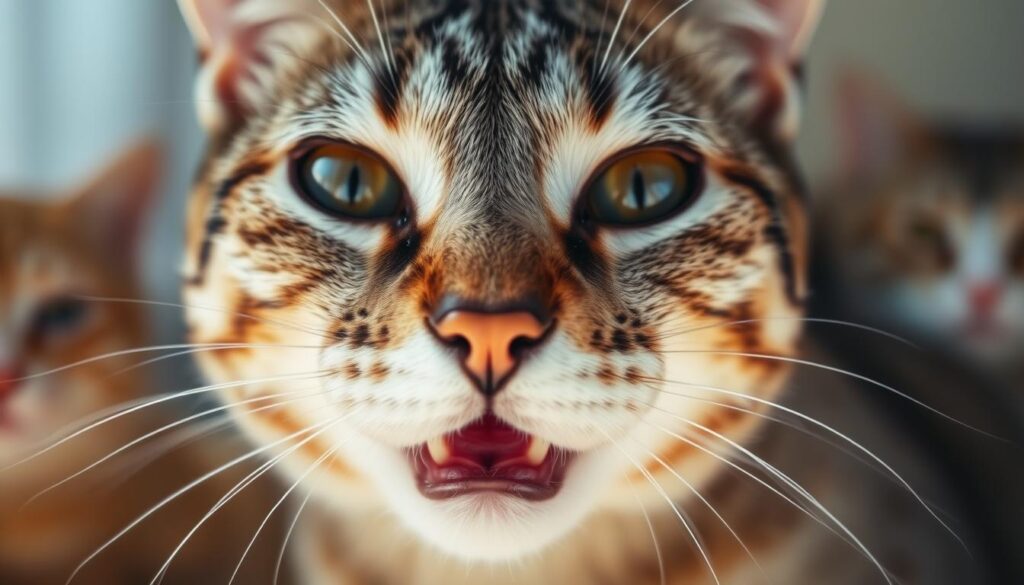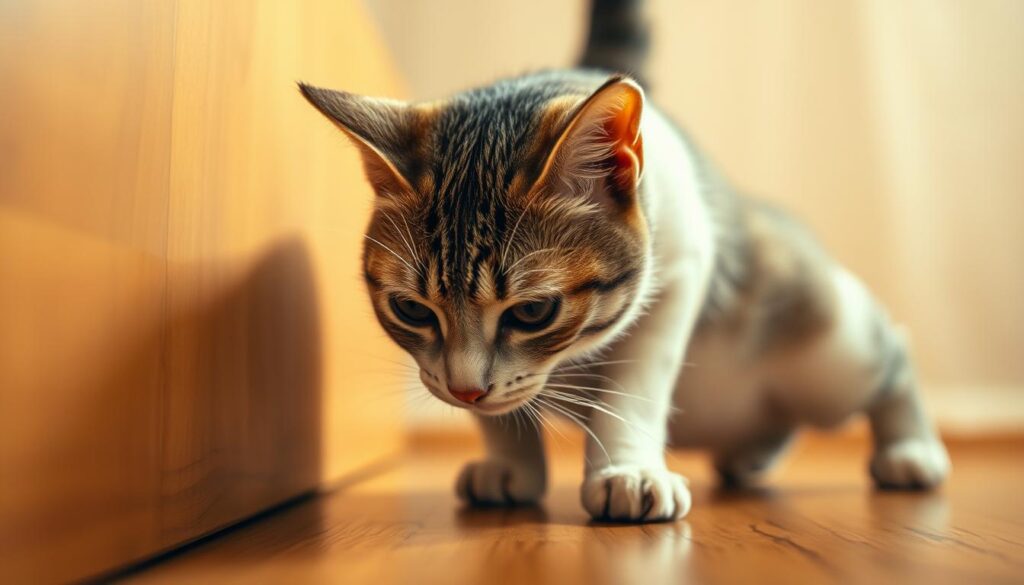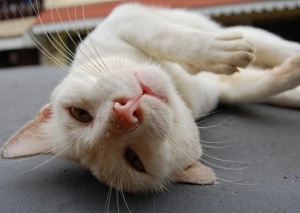Have you ever wondered what your feline companion is trying to tell you? Cats reveal their inner states through their body language, and deciphering these cues is key to a harmonious relationship.
Cats, like humans, express their emotions through various signals. By learning to read these signals, you can respond to their needs, reduce stress, and deepen your bond. This comprehensive guide will explore the fascinating world of feline communication, providing you with practical techniques to strengthen your connection with your cat.
By decoding the secret language of cats, you’ll be able to build trust and create a more meaningful relationship with your pet. Let’s dive into the world of feline communication and discover the six proven techniques to enhance your bond with your kitty.
The Secret Language of Cats: Decoding Feline Communication
Understanding the secret language of cats can deepen our bond with them. Cats use a complex system of body postures, facial expressions, and subtle vocalizations to express themselves.
Why Understanding Cat Behavior Matters
Recognizing how cats communicate is crucial for building a strong relationship with your cat. By understanding their behavior, you can identify their needs and wants, reducing stress and improving their overall well-being.
How Cats Communicate Differently Than Humans
Unlike humans, who rely primarily on verbal communication, cats use non-verbal cues. Their body language, including posture and facial expressions, conveys their intentions and emotions. For instance, a cat standing sideways may be feeling shy or preparing to escape.
Cats also use scent marking to communicate with other cats, leaving messages through scent glands on their face, paws, and tail. Understanding these differences is key to decoding their behavior and strengthening your bond with your cat.
Reading Your Cat’s Body Language
Decoding your cat’s non-verbal cues is essential for a harmonious coexistence. Cats primarily communicate through body language, using a combination of postures, facial expressions, and tail movements to convey their emotional state.
Posture and Body Position
A cat’s posture can reveal a lot about their feeling and intentions. A relaxed cat will often have a loose, open posture, while a tense cat may arch their back or crouch low to the ground. Observing your cat’s body position can help you understand their emotional state and respond appropriately.
Tail Movements and What They Mean
A cat’s tail is highly expressive and can convey a range of emotions. A twitching tail may indicate excitement or agitation, while a tucked tail can signify fear or submission. Understanding the different behaviors associated with tail movements can help you better understand your cat’s needs.
Ear Positions and Their Significance
Cat ears are highly mobile and can rotate independently to track sounds and communicate emotional states. Forward-facing, upright ears typically indicate an alert or content cat, while flattened ears can signal fear or aggression. By paying attention to your cat’s ear positions, you can gain insight into their cat feeling and adjust your interactions accordingly.
For instance, when a cat’s ears are turned back, it’s usually a good sign that they’re feeling angry or fearful. On the other hand, normal, forward ears indicate a cat that’s feeling confident or relaxed.
Understanding Cat Behavior Through Facial Expressions
The face of a cat is incredibly expressive, conveying emotions and intentions through various subtle changes. By paying attention to these facial cues, you can gain a deeper understanding of your cat’s emotional state and needs.
Eye Contact and Blinking
Eye contact is a significant aspect of cat communication. A cat’s eyes can convey a range of emotions, from aggression to affection. Direct stare can be a challenge or a threat, while avoiding eye contact may indicate fear or submission. Blinking, on the other hand, is a sign of contentment and trust. When a cat blinks at you, it’s a sign that they feel comfortable and secure in your presence.

Whisker Positions and Mouth Movements
A cat’s whiskers serve as both sensory tools and indicators of their emotional state. The position of a cat’s whiskers can signal their mood, with forward-pointing whiskers indicating confidence and curiosity, while pulled-back whiskers suggest fear or defensiveness. Mouth movements, such as lip licking or a slightly open mouth with exposed teeth, can also indicate stress or anxiety.
| Facial Cue | Emotional State |
|---|---|
| Forward-pointing whiskers | Confidence, curiosity |
| Pulled-back whiskers | Fear, defensiveness |
| Lip licking | Stress, anxiety |
| Slightly open mouth with exposed teeth | Threat, defensiveness |
By understanding these facial expressions, you can better respond to your cat’s needs and strengthen your bond with them. Recognizing signs of stress or fear can help you mitigate these feelings and create a more comfortable environment for your pet.
Decoding Cat Vocalizations
Cats use a range of vocalizations to convey their emotions and needs, from contentment to distress. These vocalizations serve as a primary means of communication between cats and their human caregivers. By understanding the different types of sounds cats make, owners can better respond to their needs and strengthen their bond.
Purring, Meowing, and Trilling
Cats employ various vocalizations to communicate different messages. Purring is often a sign of contentment or self-soothing, while meowing can indicate a need or desire, such as hunger or attention. Trilling, a less common sound, is typically a sign of excitement or happiness, often used by mother cats to communicate with their kittens. Understanding these vocalizations can help cat owners better understand their cat’s emotional state.
Warning Sounds: Hissing, Growling, and Yowling
When a cat feels threatened or scared, they may produce warning sounds to deter potential threats. Hissing and growling are clear indicators that a cat is feeling defensive or frightened. Yowling, a loud, drawn-out vocalization, can signify distress, territorial disputes, or mating behaviors. Recognizing these warning sounds is crucial for preventing escalation to physical aggression.
| Vocalization | Meaning | Context |
|---|---|---|
| Purring | Contentment or self-soothing | Relaxation, happiness |
| Meowing | Need or desire | Hunger, attention-seeking |
| Trilling | Excitement or happiness | Mother-kitten interaction, play |
| Hissing | Fear or defensiveness | Threat response, fear |
| Growling | Serious discomfort or fear | Defensiveness, threat response |
| Yowling | Distress, territorial dispute, or mating | Stress, mating season, territorial conflict |
Trick #1: The Slow Blink Technique
The slow blink technique is a powerful tool for bonding with your cat, leveraging their natural language to build trust. This simple yet effective gesture can significantly enhance your relationship with your feline companion.
When you slow blink at your cat, you’re essentially saying, “I feel safe enough around you to temporarily close my eyes.” This is particularly significant coming from a potential predator, as it demonstrates vulnerability and trust. In cat society, direct staring is typically seen as threatening, while closing one’s eyes in another’s presence shows trust.
How to Perform the “Cat Kiss”
Performing the slow blink technique, often referred to as a “cat kiss,” is straightforward. First, ensure you’re in a calm environment where your cat feels relaxed and secure. Look at your cat and blink slowly. You can also start by blinking naturally and then slowing down your blinks. It’s essential to be patient and let your cat respond.
Why This Creates Trust and Bonding
The slow blink technique is effective because it speaks directly to cats in their natural language, showing that you understand and respect their communication style. By doing so, you’re helping to reduce your cat‘s stress levels and confirming that you’re not a threat. Regular practice of this technique helps establish a pattern of positive, non-threatening interactions that build trust over time. As you continue, many cats will eventually initiate this exchange themselves, creating a special non-verbal conversation between you and your pet, enhancing the bond and trust in your relationship.
By incorporating the slow blink technique into your daily interactions, you’re not just communicating with your cat; you’re also showing affection and building a deeper connection. This gesture, which involves a relaxed body language, fosters a sense of safety and understanding, crucial for a healthy and happy relationship with your feline friend.
Trick #2: Creating Safe Spaces for Your Cat
A cat’s sense of security is closely tied to its environment, making safe spaces essential. Cats often seek out elevated areas or hiding spots where they can observe their surroundings without being disturbed. By providing such spaces, you can help reduce your cat’s stress levels and strengthen your bond.
Setting Up Elevated Perches and Hiding Spots
To create a comfortable environment for your cat, consider setting up elevated perches or cat shelves where they can rest and observe their surroundings. You can also provide hiding spots, such as cardboard boxes or tunnels, to give your cat a sense of security and control. Elevated perches are particularly beneficial as they allow your cat to survey their territory without feeling vulnerable.
Respecting Your Cat’s Need for Territory
It’s essential to respect your cat’s territorial needs by providing multiple resources throughout your home, including food bowls, water dishes, litter boxes, and resting areas. In multi-cat households, this is particularly important to prevent competition and stress. Following the “n+1” rule for litter boxes, where you have one more box than the number of cats, can also help reduce stress related to litter box sharing. Allowing your cat to establish their own territory gradually will help them feel more secure and in control.
By creating safe spaces and respecting your cat’s territorial needs, you can significantly improve their emotional well-being and strengthen your bond with them.
Trick #3: Proper Play Techniques
To build a strong bond with your cat, it’s essential to understand and implement proper play techniques. Engaging your cat in activities that mimic their natural hunting behaviors can significantly enhance your relationship and satisfy their instinctual needs.
Interactive Toys vs. Hand Play
When it comes to playtime, you have two main options: interactive toys or hand play. Interactive toys allow your cat to engage in hunting behaviors without the risk of injury from your hands. Wand toys with feathers or other attachments are excellent examples. On the other hand, some cats prefer hand play, but it’s crucial to establish boundaries to avoid encouraging biting or scratching.
Mimicking Natural Hunting Behaviors
Cats are ambush predators, and their natural hunting sequence involves stalking, chasing, pouncing, and “killing” their prey. To effectively engage your cat during play, you should mimic these behaviors. Move toys unpredictably, hide them behind furniture, and occasionally freeze in place to trigger your cat’s hunting response. Allow your cat to “catch” and “kill” the toy to prevent frustration.
| Play Technique | Description | Benefit |
|---|---|---|
| Interactive Toys | Wand toys with feathers or attachments | Encourages hunting behavior without injury risk |
| Mimicking Prey Movement | Unpredictable movements, hiding, and freezing | Triggers natural hunting response |
| Allowing “Kill” | Letting cat catch and “kill” toy | Prevents frustration, satisfies hunting instinct |
End play sessions with a small treat or meal to complete the natural hunting sequence, as cats in the wild would eat after a successful hunt. Observing your cat’s body language during play can help you tailor your techniques to their preferences, ensuring a fun and engaging experience for your cat.
Trick #4: Positive Reinforcement Training
Positive reinforcement training is a powerful tool for strengthening your bond with your cat. This method focuses on rewarding desired behaviors rather than punishing undesired ones, creating a positive and supportive learning environment.
Engaging your cat in play and exercise can help reduce their stress and anxiety. By incorporating positive reinforcement training into your daily routine, you can further enhance your cat‘s well-being and encourage good behavior.
Clicker Training Basics for Cats
Clicker training is a form of positive reinforcement that uses a distinct sound, such as a clicker, to mark desired behaviors. By associating the sound with rewards, you can effectively teach your cat new tricks and behaviors. To start, you’ll need a clicker and some treats that your cat enjoys.
Simple Tricks to Teach Your Cat
Teaching your cat simple tricks provides mental stimulation, builds confidence, and strengthens your communication and bond. Some simple tricks to start with include:
- Target training: teaching your cat to touch their nose to a stick or your finger.
- “Sit”: holding a treat above your cat‘s head to encourage them to sit.
- “High five” or “paw”: rewarding your cat for lifting their paw.
- “Come when called”: associating your cat‘s name with positive experiences and rewards.
Always use patience and positive reinforcement when training your cat, and be attentive to their signs of stress or frustration, giving them the attention they need.
Trick #5: The Art of Cat Massage
The art of cat massage is a simple yet effective way to show your cat love and care. Massaging your cat can help reduce stress levels, strengthen your bond, and potentially identify health issues through regular handling.
Finding Your Cat’s Preferred Touch Zones
Gentle massage techniques can be applied to various areas of your cat’s body. Circular motions with your fingertips around the cheeks, forehead, and base of the ears often elicit positive responses from most cats. It’s essential to begin massage sessions when your cat is already relaxed and receptive to touch.
Techniques for Relaxing Your Cat
Use gentle, slow strokes rather than vigorous petting, maintaining consistent pressure that’s firm enough to be felt but light enough to be comfortable. Combining massage with gentle grooming using a soft brush can also be beneficial for cats that enjoy being groomed, as it mimics social grooming behaviors between bonded cats.
Always respect your cat’s signals—if they move away or show signs of discomfort, end the session and try again later when they’re more receptive. By incorporating massage into your daily routine, you can significantly improve your cat’s comfort and trust.
Trick #6: Communication Through Scent
Scent plays a crucial role in the feline world, serving as a primary means of communication among cats. Cats use scent as a major form of communication, marking their territory and leaving messages for other cats through scent glands located on their face, paws, and tail.
Using Pheromone Products to Reduce Stress
Pheromone products mimic the calming scents that mother cats produce to calm their kittens. These products can help reduce your cat’s stress levels by creating a calming environment. They are particularly useful during changes in your cat’s environment, such as moving to a new home or introducing new pets.
Scent Swapping and Bonding
Scent swapping is a powerful technique for bonding with your cat. You can do this by gently rubbing a soft cloth on your cat’s cheeks and then applying this cloth to your hands or clothing, allowing your cat to become familiar with your scent. This technique is especially useful when introducing new cats to each other.

Recognizing Signs of Distress in Your Cat
Cats display distress through a range of behavioral and physical changes that owners should be aware of. Understanding these signs is crucial for providing a comfortable and safe environment for your feline friend.
Physical Signs Your Cat Is Uncomfortable
When cats are stressed or anxious, they may exhibit physical signs such as changes in appetite or grooming habits. For instance, a cat may lose interest in food or over-groom themselves. Litter box issues are also a common indicator of distress, where cats may avoid using the litter box or show discomfort while using it.
Behavioral Changes That Indicate Stress
Behavioral changes are often the first indication that your cat is experiencing stress or discomfort. Some common signs include:
- Increased hiding behavior or seeking isolation in unusual places
- Changes in appetite, either decreased interest in food or sudden increased hunger
- Litter box avoidance or elimination outside the box
- Increased aggression or excessive vocalization
Conclusion: Building a Lifelong Bond With Your Feline Friend
Nurturing a strong bond with your cat requires patience, understanding, and a willingness to learn their unique language. By learning to read your cat’s body language and respecting their natural behaviors and preferences, you create a foundation of trust that strengthens over time.
The six tricks we’ve covered work together to create a comprehensive approach to feline bonding. Slow blinking, creating safe spaces, proper play techniques, positive reinforcement training, gentle massage, and scent communication are all essential tools in your bonding toolkit. Remember, every cat is unique, so it’s crucial to adapt these techniques to suit your particular cat’s needs and temperament.
When in doubt about changes in your cat’s behavior or if they show signs of distress, consult with your veterinarian to rule out medical causes. By investing time and effort into understanding your cat, you’ll be rewarded with a deep, meaningful connection that enriches both your lives.










